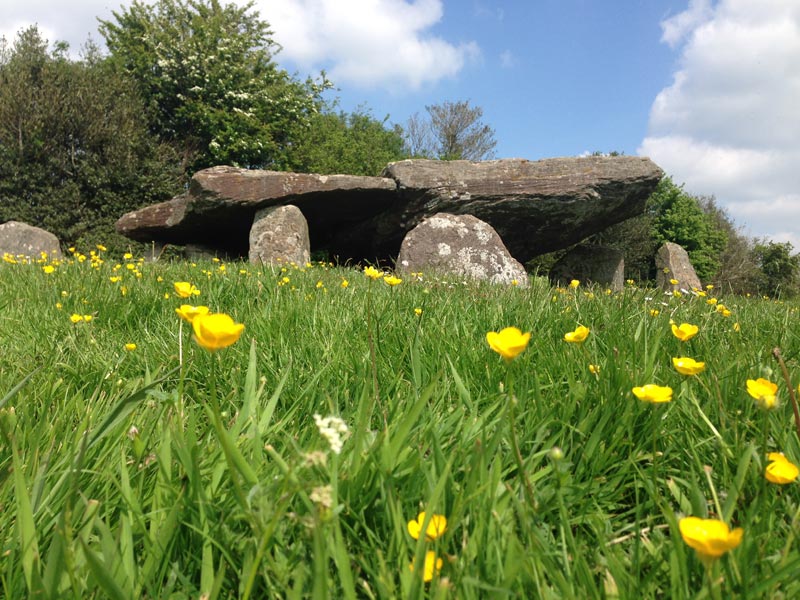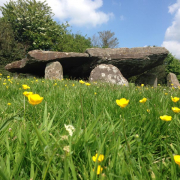MONTHLY BLOG 178, THINKING THROUGH TIME AT ARTHUR’S STONE IN HEREFORDSHIRE
If citing, please kindly acknowledge copyright © Penelope J. Corfield (2025)

|
Fig.1 Arthur’s Stone (Herefordshire), |
Great rings of giant standing stones, dating from primeval times – such as England’s Stonehenge and Brittany’s Carnac Stones – are wonderful prompts to sweeping thoughts about the length of Time and History.1 Yet small ancient monuments can be just as striking in their own way. On a very pleasant visit to Herefordshire in summer 2016, my partner and I decided, on the spur of the moment, to follow a signpost to view a historic burial tomb, named Arthur’s Stone. It proved to be wonderfully thought-provoking.
Arthur’s Stone (today guarded by English Heritage)2 is set high on a ridge between the Wye and Golden Valleys. The site is magnificent. The Stone burial chamber, which was constructed in c. 3,000 BCE, is somewhat dilapidated but that through-Time quality adds to its authenticity. Its impact is dignified without being grandiose. Interested visitors attend in small numbers rather than in great crowds. Yet the simplicity and venerability of the monument, and the tranquillity of its location, together give the Stone great resonance.
In the first place, it is evidence of serious intent on the part of those who placed the Stone high on the ridge. It may have been installed as an astronomical observation point – a function which is claimed (and debated) in the case of many ancient stone monuments. Certainly, none of these sites were constructed out of the blue. They indicate the existence of societies capable of planning, organising and implementing big communal projects. And they were ingenious makers and users of flint tools. Hence it’s not surprising that in the vicinity of Arthur’s Stone, there’s evidence of prior human labour in the form of numerous even older flint flakes and arrow-heads.
Whether this particular monument was built as a tomb, or instead as some form of storage chamber, is unknown. There are other similar monuments in the region, which are known as the ‘Severn-Cotswold’ group of chambered tombs. And there would have been regular communication links between these sites. Thus, while research has yet to reveal the precise functions of all these carefully-positioned great stones, it is clear that they had a significant role for those who manoeuvred them into their special sites. From the start, they had meaning.
A further intriguing train of thought is prompted by the attempts of later generations to ‘domesticate’ these historical markers by associating them with famous personages.3 So at some stage, long before the thirteenth century CE, this monument, like many other historic stones and relics, became associated in popular legend with the feats of King Arthur. Stories abounded. One reported that he had won a battle there. Another story recounted that he’d met a giant there and triumphantly slain him. Either way, Arthur’s Stone was being given a place in the epic history of the legendary British king. And the name has stuck.
Thereafter, the site has seen some real documented drama as well. In the fifteenth century, a knight was killed there in a fatal duel. And in September 1645 the embattled King Charles I dined at the Stone with his Royalist troops. Perhaps he intended the occasion as a symbolic gesture, although it did not confer upon him sufficient pseudo-Arthurian lustre to defeat Cromwell and the Roundheads. Charles I’s fleeting visit thus did not enter local folklore.
Then at some stage (the precise date is unknown), the site became a focal point for locally popular festivities at midsummer. Villagers in the nearby settlements of Dorstone and Bredwardine gathered in the sloping field in front of Arthur’s Stone, where they engaged in uninhibited drinking, dancing and ‘high jinks’ – away from the inquisitorial eye of the local clergy and magistrates. It was obviously fun, because the popular tradition continued well into Victorian times.
As a sober counter-balance, too, the local Baptists began in the nineteenth century to organise an ecumenical religious service there in high summer. Implicitly, they were saluting the Stone’s sacral reputation, whilst simultaneously purging its more recent pagan associations.
On my own visit there, I met by complete chance a charming senior citizen who lived locally.4 She told me of her personal memories, as a child before World War II, when she joined her school-fellows to sing hymns at the services held there each midsummer. It was a stirring occasion for them all.
The special nature of the place was (and is) undoubted. Throughout its five thousand years of existence, Arthur’s Stone has had multiple meanings and uses for the witnessing generations who both live nearby and visit from afar. Its story is protean. Whether the site is used for astronomy, royal burial, knightly duelling, open-air royal dining, unorthodox popular festivities, community religious services, or (today) for tourist visiting, Arthur’s Stone cannot be locked away into a wrongly named ‘pre-history’.
It does not spring from a long-gone era whose name implies that it pre-dates ‘real’ History.5 On the contrary. Arthur’s Stone has always been fully within History, which continues to unfold steadily, as long as Time itself does likewise. The great cosmic story is one that welds together both deep continuities and recurrent change. Local monuments do the same. In other words, Arthur’s Stone silently signals Time’s diachronic power to persist and to update simultaneously. And long may it continue to do so!
ENDNOTES:
1 For more on Time & History, see P.J. Corfield, Time-Space: We Are All in it Together (London, 2025).
2 See https://www.english-heritage.org.uk/visit/places/arthurs-stone.
3 For further information, see also A. Watkins, ‘Arthur’s Stone’, Transactions of the Woolhope Naturalists’ Field Club (1928), pp. 149-51; L.V. Grinsell, Folklore of Prehistoric Sites in Britain (1976); and J. Sant, Stone Spotting in Herefordshire (2000);
4 With reiterated thanks and warm appreciation to Ionwen E. Williams (née Davies).
5 For a further critique of the concept of ‘Prehistory’, see PJC, ‘Primevalism: Saluting a Renamed Prehistory’, in A. Baysal, E.L. Baysal and S. Souvatzi (eds), Problematising Time and History in Pre-History (2019), pp. 265-82.
For further discussion, see Twitter
To read other discussion-points, please click here
To download Monthly Blog 178 please click here

